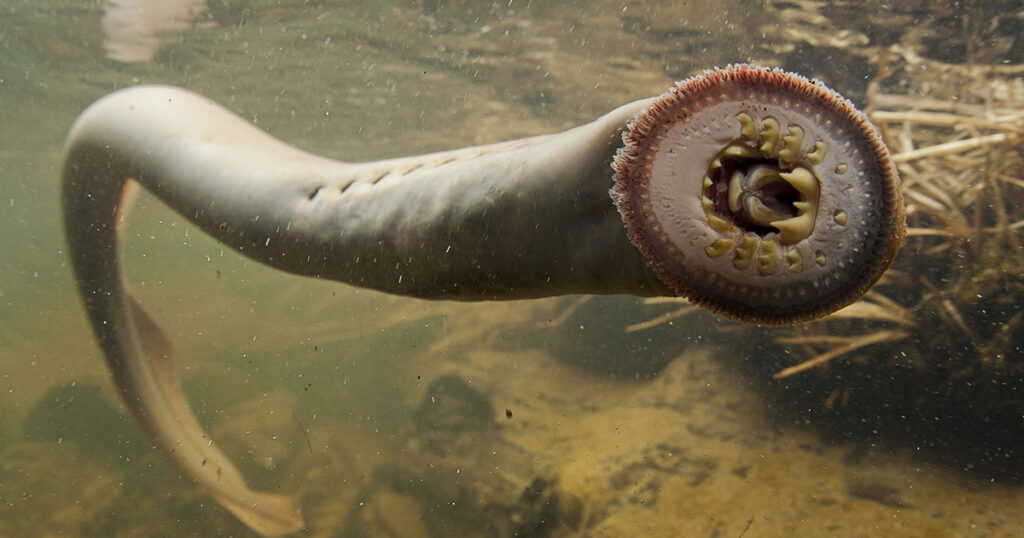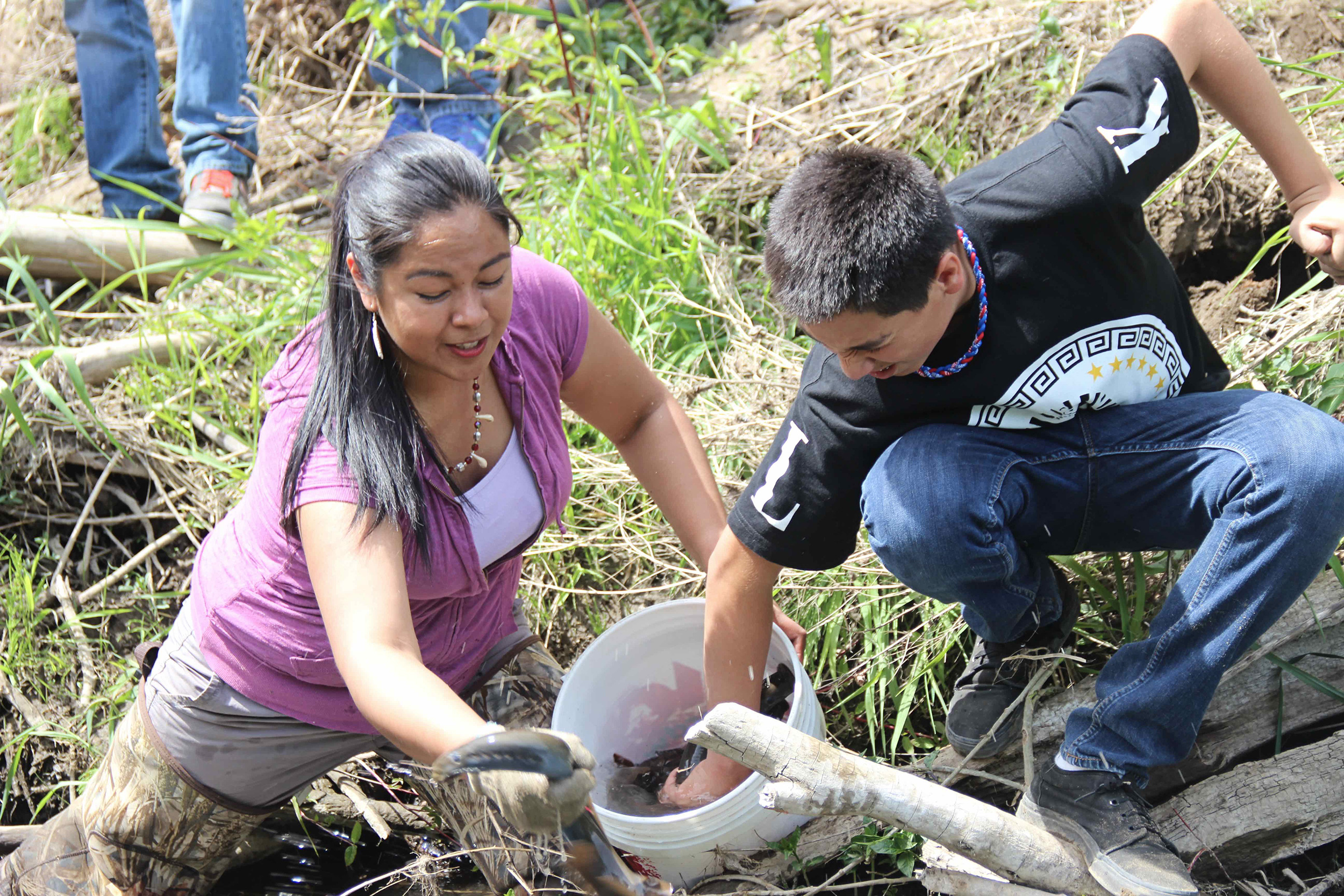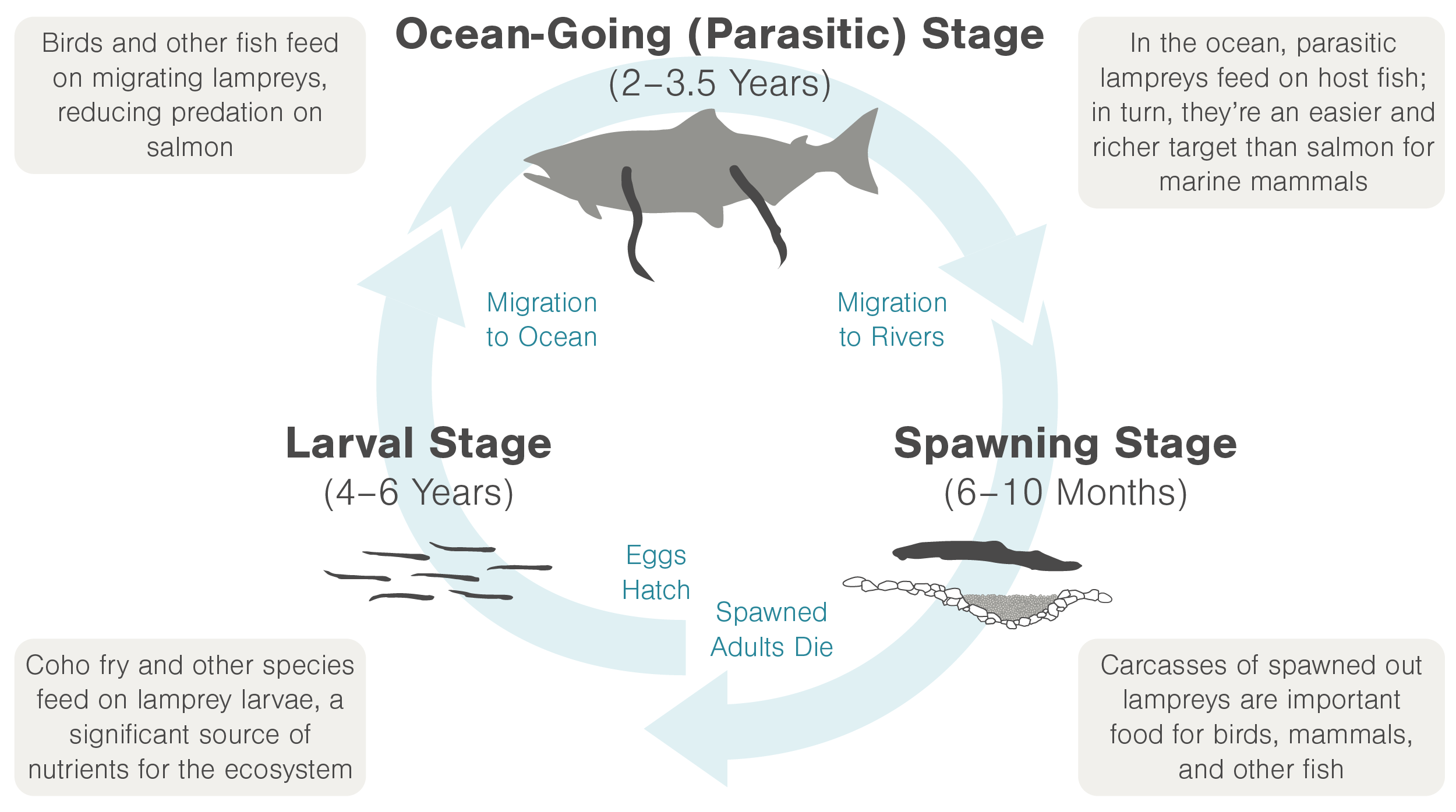

It’s hard to blame them: lampreys rank somewhere between cobras and crocodiles on the charisma spectrum. The fish’s slimy, boneless body culminates in a tooth-studded “oral disc,” which it can use to suction to larger fish and slurp its host’s bodily fluids. Supersize a leech to the length of a baseball bat, give it three fangs surrounded by rows of smaller teeth, and—voila—you’ve created a Pacific lamprey.

A student from Mt. Adams Middle School conquers his squeamishness to help Emily Washines release a lamprey into Washington’s Toppenish Creek. Photo by Ben Goldfarb
But while lampreys may not win any piscine beauty pageants, they’re crucial members of Pacific Northwest ecosystems. Larval lampreys are filter feeders, capable of improving water quality as they inhale nutrients. Meanwhile, the oily, lipid-rich adults—“the bacon cheeseburgers of the stream,” as one biologist puts it—provide sustenance to everything from bears to mink. From plankton to plants, sturgeons to sea lions, if it flies, swims, or crawls in the Northwest, it’s probably closely linked to Entosphenus tridentatus.
The lamprey’s ecological importance, however, has not earned it much respect from Homo sapiens. Human industry and infrastructure have pushed Pacific lampreys into steep decline, yet only recently did we notice their disappearance from creeks like Toppenish. The Northwest is salmon country, and lampreys—secretive, homely, without angling appeal—were long its forgotten fish.
In recent years, the lamprey’s plight has at last attracted public concern. In the Columbia River Basin, the vast watershed that drains seven American states and one Canadian province, lampreys are the target of a multi-million-dollar recovery effort, spearheaded by the Yakama, Umatilla, Nez Perce, and other native tribes for whom the lamprey is a cultural and culinary touchstone. If lampreys return from the brink, it will be the tribes who brought them back.
Washines, who runs outreach for the Yakama Nation’s fisheries program, has come to Toppenish Creek to take one small step toward resuscitating the species. With the students looking on, she slips her lamprey into the creek’s tea-colored flow. The fish swiftly latches itself to a rock. This is a pregnant female, ready to drop 40,000 eggs—each barely larger than a period on your screen—into the gravel of an upstream pool. Another dozen lampreys cling to the bucket balanced on Washines’s thigh, waiting to re-enter their element.

Biologist Ralph Lampman releases a Pacific lamprey into the North Umpqua River. Photo by Jeremy Monroe/Freshwaters Illustrated-USFWS
Along the bank, a lanky boy, grinning uncertainly, finally steps forward to wrestle a lamprey from the bucket and deposit it into the creek. Ralph Lampman, the biologist overseeing the proceedings, applauds. The Pacific lamprey’s charm may be lost on most people, but it has a devotee in this slim, soft-spoken scientist, who once asked his wife if he could change his last name to Lampreyman. She’d threatened divorce.
“We’re doing everything we can,” Lampman tells me later. “But these are some big issues that we’re dealing with. It’s hard to fix everything.”
Lampreys have been around for some 450 million years—longer than dinosaurs, longer than trees—and they look their age. Though they superficially resemble eels, their ancient anatomy is far stranger: their sucker mouth evolved before animals started to develop jaws; their skeleton is made of cartilage, like a shark’s; and they have but one nostril, smack in the middle of their heads. Lampreys lack pectoral and pelvic fins, the paired appendages that jut out from the side of nearly all other fish and from which sprang our own arms and legs; instead, their fins run down the center of their backs. “They make you feel like you’ve stepped into a time machine,” Lampman says fondly.

Illustration by Mark Garrison
Like salmon, Pacific lampreys are anadromous: they’re born in fresh water, pass their adult lives in the ocean, and migrate back upriver to spawn. (While most salmon complete their life cycle in around five years, lampreys require up to 11 years to finish the round trip.) Historically, thousands of lampreys followed the Snake River, a 1,700-kilometer tributary of the Columbia, as far inland as Idaho; along the way, uncountable legions diverged into tributaries like the Willamette, the Yakima, and the Grand Ronde. Writer Timothy Egan described the Northwest as “anywhere a salmon can get to.” He could have said the same of lampreys.
But a half-billion years of success doesn’t guarantee survival in the Anthropocene. Between 1937 and 1975, the federal government built eight massive, fish-impeding hydroelectric dams on the lower Columbia and Snake. Salmon and steelhead runs plummeted, and 13 stocks were eventually placed on the endangered species list. The listings launched myriad recovery projects, from fish passage structures to habitat restoration to hatchery construction. These days, the government spends over US $500-million on salmon recovery in the Columbia Basin each year.

Dams along the Columbia River and its tributaries contributed to the decline of Pacific lampreys. Illustration by Mark Garrison
By contrast, folks didn’t much care about the odd, prehistoric fish that shared the watershed with salmonids. Pacific lampreys were never as loathed as their Atlantic cousins, sea lampreys, which invaded the Great Lakes in the 20th century and are today sterilized, trapped, and poisoned. But Northwesterners didn’t cherish their lampreys, either. When lampreys stuck themselves to dam viewing windows, fish counters zapped them with electrodes so that they wouldn’t obstruct salmon. Farmers complained that lampreys clogged irrigation screens, and Oregon poisoned lampreys and other so-called “trash fish” into the 1980s.
What’s more, salmon-friendly infrastructure offered little help to lampreys. Compared to salmon, lampreys are mediocre swimmers, ill suited to navigating the right angles and fast flows they encounter in fish ladders. They often have to rest, latching onto surfaces with their mouths (the word “lamprey” descends from the Latin lampreda, or “stone-licker”). Though salmon survival rates at the dams climbed to over 90 percent, only about 50 percent of lampreys made it through. Even when lampreys reached spawning grounds, their offspring perished. Poor land use practices deprived their filter-feeding larvae, called ammocoetes, of river-bottom sediment in which to bury themselves; in other places, irrigation diversions left larvae high and dry. “If the ammocoetes can’t burrow into the substrate, it doesn’t matter if the adults can get up to spawn,” says Jeff Jolley, a fisheries biologist with the US Fish & Wildlife Service (USFWS).
In this three-minute video, Aaron Jackson of the Confederated Tribes of the Umatilla Indian Reservation explains how the plight of the Pacific lamprey impacts his community and the steps tribes are taking to restore the fish for future generations. Footage adapted from the film The Lost Fish ©Freshwaters Illustrated thelostfish.org
Given that litany of obstacles, it’s no wonder their numbers nosedived. Historic data is sketchy, but annual runs averaged well over 100,000 as recently as the 1960s. By 2010, that number had plunged to 6,000. The further inland, the uglier the declines. In 2009, just 12 lampreys were counted at Lower Granite Dam, the final big dam on the lower Snake River. When USFWS researchers completed a sweeping assessment of the species, they found it had vanished throughout much of Idaho and eastern Oregon. In many tributaries, the forgotten fish was functionally extinct.
One group, however, never forgot about lampreys: the Columbia River tribes. For thousands of years, the fish, along with salmon, deer, huckleberry, and other so-called “first foods,” had featured prominently in tribal diets and ceremonies. Davis Washines, Emily’s uncle, recalls yanking lampreys off rocks and cramming them into gunnysacks during his youth in the 1960s. His mother hung them over poles and dried them, hundreds at a time, in the sun.
“When you were an infant, you would suck on the tails as a pacifier,” remembers Washines, a smile creasing his weathered face. “That’s how you acquired the taste.”
In the 1970s, Washines and other tribal members began to notice that the once-reliable lampreys had begun to vanish. In 2004, the tribes convened a Lamprey Summit to voice their fears to heavy-hitting agencies, including the US Army Corps of Engineers, which operates the dams, and the Bonneville Power Administration, which sells the electricity. More summits followed, and in 2007 the Fish and Wildlife Service launched an overdue lamprey-conservation initiative. “The tribes were the ones who precipitated it,” says Christina Wang, the USFWS biologist who helps coordinate the program. “They said the declines are real, and we need a call to action.”

Pacific lampreys were once abundant in the Columbia River Basin but have suffered drastic declines. Photo by Jeremy Monroe/Freshwaters Illustrated-USFWS
Tribes also began taking matters into their own hands by translocating lampreys into streams above the dams. The festive release into Toppenish Creek is one such translocation. Last summer, Yakama biologists captured lampreys at Bonneville Dam and trucked them to a laboratory. The transplants lived there for 10 months in a concrete tank, not even eating, before finally ending up in Emily Washines’s bucket and being turned loose by the squeamish middle-schoolers. (Unlike salmon, which spawn soon after entering fresh water, Pacific lampreys can take up to three years to get in the mood.) In 450 million years, few lampreys have ever experienced such a strange journey.
The Yakama hope that lampreys will beget lampreys. While salmon hone to their natal streams, lampreys appear to follow the pheromones of their own species, wherever those smells may lead. It’s a clever strategy: if adults and ammocoetes are laying down chemical trails upstream, it suggests fish are spawning and the habitat is livable. It also means that if you plant a few ripe lampreys in a creek like Toppenish, they may lure others.
“Ultimately we want natural production,” says Patrick Luke, the former lamprey biologist who spearheads the Yakama Nation’s Pacific Lamprey Program. Like Davis Washines, Luke grew up with lampreys—he roasted the fish on sticks, hot dog style, over campfires, and his relatives rendered their oil into an ointment for cuts and earaches. “There’s an Indian law that says we need to take care of our foods, and our foods will take care of us.”
Two days later, 160 kilometers southeast of Toppenish Creek, I stand alongside Gary James on a platform overlooking Three Mile Falls Dam, a concrete blockade, as long as a battleship and as high as the Great Wall of China, that interrupts the Umatilla River.
James, the chipper, salt-and-pepper-haired program manager of the Umatilla fisheries department, gestures toward the green churn of crashing water at the dam’s base. “This is pretty cool,” he shouts above the roar, grinning through his goatee. “You can see where they’ve stopped to rest.”
My gaze follows his finger to a metal tank suspended above the river, its lid thrown open to reveal a writhing brown knot. I lift my camera and zoom in. Sure enough, the squirming tangle resolves into a half-dozen lampreys, mouths fastened to the rust-streaked walls.
The resting box is one component of a slanted aluminum ductwork rising up alongside the dam like an industrial air-conditioning system—a lamprey ramp, custom built in 2009. Though lampreys are mediocre swimmers, they’re adroit climbers, capable of inching up smooth rock faces—or aluminum walls—with their all-purpose mouths. Before the ramp was installed, less than 30 percent of approaching lampreys surmounted this dam. Today, 70 percent make it over.
Lamprey ramps don’t come cheap: a structure installed at McNary Dam on the Columbia River in 2014, for instance, cost over $300,000. Since 2008, however, the region has been flush with lamprey dollars thanks to the Columbia Basin Fish Accords, a deal through which the US government granted Northwest tribes and states nearly a billion dollars to recover fish and wildlife. Though most of the money went toward helping salmon, the accords also devoted $50-million to lamprey research and restoration, from safer passage structures to a minuscule tag that will allow scientists to track juveniles on their way to sea.

Compared to salmon, Pacific lampreys are weak swimmers, but they can climb smooth surfaces using suction. Photo by David Herasimtschuk/Freshwaters Illustrated-USFWS
But the money came with a catch. The accords expressly barred the tribes from petitioning to add the Pacific lamprey to the endangered species list, despite a strong case for formal protection. Back in 2004, the USFWS rejected a petition from environmental groups, largely because not enough was known about the lamprey to conclude that it was in peril. Call it the not-so-precautionary principle.
A decade later, however, the Pacific lamprey’s decline is clearer than ever, and the Feds are scrambling to keep the species off the list. The recalcitrant Army Corps is finally pursuing best practices, including rounding off right angles on fish ladders, installing smaller screens so that juveniles don’t get stuck, and reducing flows at night, when lampreys travel. It’s a preemptive strike against the regulations that would come with a listing. “We’re always prepared for a petition, but we’re trying to do as much as we can now so they don’t need to be listed,” says USFWS’s Christina Wang.
A petition could someday come from the Nez Perce, which declined to sign the accords so that it could keep up its long-running legal battle against the federal government’s fish management strategy. Last fall, the tribe joined a lawsuit against the Army Corps, which wanted to dredge the Snake to keep the river open for barge traffic. The tribe feared the project would disturb larvae, but the judge allowed dredging to proceed.
To the Nez Perce, the affair suggested that lampreys still remain an afterthought. Yes, more than 30,000 lampreys passed Bonneville Dam in 2014—five times more than in 2010—but that’s still a fraction of historic runs. “We’re studying these fish to death,” says Dan Kane, a member of the Nez Perce’s Executive Committee. “We’re still so far from integrating this resource back into our culture and diet.”
Though lampreys have a long way to go, they’ve traveled some hard miles already. When fisheries program manager Gary James began working for the Umatilla in 1982, the Umatilla River lacked water, let alone fish. Most of its flow had been diverted for irrigation. But the tribe struck a bargain with farmers and the federal government to re-water the river. In 2000, the tribe began planting lampreys. No one had yet attempted translocation, and the lamprey’s lengthy life cycle made it impossible at first to judge the plan’s efficacy. Finally, in 2011—right on schedule—the translocation began to pay dividends. In 2014, 404 lampreys undulated into the Umatilla River. “Now there are juveniles swimming around all over the basin,” James says.

Throughout their life cycle, Pacific lampreys are an important component of the food web in the Pacific Northwest ecosystem. Illustration by Mark Garrison
After our tour of Three Mile Falls Dam, James takes me to see another initiative in the restoration of Umatilla River lampreys, at a laboratory housed within Walla Walla Community College. Back in 2011, the tribes hosted biologists from Finland and Japan, lamprey-eating countries that have figured out how to raise the critters in captivity. Now the Umatilla are trying to master artificial propagation. Translocation, James says, can only get lampreys so far. The tribe needs to produce more fish, and quickly.
The hatchery occupies just a few shoebox-sized bins perched on a flimsy shelving unit. A printed sign reads “EXPERIMENT IN PROGRESS. DO NOT TOUCH OR MOVE.” A jury-rigged matrix of recirculating pumps hisses in the background. The lab’s scrappy vibe evokes the science-fair project of an overachieving high-school student.
Alexa Maine, a red-haired, businesslike biologist, shows me around. A pollen-like layer of lamprey eggs dusts the bottom of one tank. Another tank, filled with murky water and sediment, holds around 50 larvae. Maine and her colleagues recently performed surgery on each one, cutting tiny incisions just behind their gill slits and slipping in tags where the ribs would be, if lampreys had ribs. The hope is that fish born in captivity will someday be released into the river, and that data collected via the tags will provide new insight into this cryptic creature’s habits.